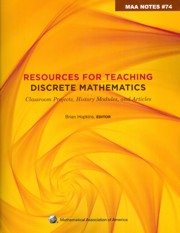Book contents
- Frontmatter
- Introduction
- Dedication
- Contents
- I Classroom-tested Projects
- The Game of “Take Away”
- Pile Splitting Problem: Introducing Strong Induction
- Generalizing Pascal: The Euler Triangles
- Coloring and Counting Rectangles on the Board
- Fun and Games with Squares and Planes
- Exploring Recursion with the Josephus Problem: (Or how to play “One Potato, Two Potato” for keeps)
- Using Trains to Model Recurrence Relations
- Codon Classes
- How to change coins, M&M's, or chicken nuggets: The linear Diophantine problem of Frobenius
- Calculator Activities for a Discrete Mathematics Course
- Bulgarian solitaire
- Can you make the geodesic dome?
- Exploring Polyhedra and Discovering Euler's Formula
- Further Explorations with the Towers of Hanoi
- The Two Color Theorem
- Counting Perfect Matchings and Benzenoids
- Exploring Data Compression via Binary Trees
- A Problem in Typography
- Graph Complexity
- II Historical Projects in Discrete Mathematics and Computer Science
- III Articles Extending Discrete Mathematics Content
- IV Articles on Discrete Mathematics Pedagogy
- About the Editor
Counting Perfect Matchings and Benzenoids
from I - Classroom-tested Projects
- Frontmatter
- Introduction
- Dedication
- Contents
- I Classroom-tested Projects
- The Game of “Take Away”
- Pile Splitting Problem: Introducing Strong Induction
- Generalizing Pascal: The Euler Triangles
- Coloring and Counting Rectangles on the Board
- Fun and Games with Squares and Planes
- Exploring Recursion with the Josephus Problem: (Or how to play “One Potato, Two Potato” for keeps)
- Using Trains to Model Recurrence Relations
- Codon Classes
- How to change coins, M&M's, or chicken nuggets: The linear Diophantine problem of Frobenius
- Calculator Activities for a Discrete Mathematics Course
- Bulgarian solitaire
- Can you make the geodesic dome?
- Exploring Polyhedra and Discovering Euler's Formula
- Further Explorations with the Towers of Hanoi
- The Two Color Theorem
- Counting Perfect Matchings and Benzenoids
- Exploring Data Compression via Binary Trees
- A Problem in Typography
- Graph Complexity
- II Historical Projects in Discrete Mathematics and Computer Science
- III Articles Extending Discrete Mathematics Content
- IV Articles on Discrete Mathematics Pedagogy
- About the Editor
Summary
Summary
The connection between perfect matchings and benzene was discovered by the German chemist Kekulé in the mid 1800s. Subsequently, chemists have learned that the number of perfect matchings contained in a molecular model is an important parameter related to chemical stability. Hence, counting perfect matchings has been an important problem in chemistry for over 50 years. However, counting perfect matchings in general graphs is a computationally difficult problem. Consequently, chemists and graph theorists have developed efficient counting methods for certain classes of graphs that arise in modeling special hydrocarbons called benzenoids. Many of these methods involve counting principles usually discussed in discrete mathematics courses. In this article we discuss several of these methods and show how to implement a general determinant based formula.
Notes for the instructor
This project works well as an enrichment topic for an advanced discrete mathematics course focused on applications. Students should be familiar with counting techniques, graphs and determinants. I usually give the paper to students to read and then present a summary of the material at the end of the course. I spend roughly one class meeting on it. Exercises that reinforce and extend some key ideas are given in the last section, along with selected solutions.
Bibliography
[1] J. Aihara, “Why Aromatic Compounds Are Stable,” Scientific American 266(3) (1992) 62–68.
[2] S. Cyvin and I. Gutman, Kekulé Structures in Benzenoid Hydrocarbons, Springer-Verlag, New York, 1988.
Information
- Type
- Chapter
- Information
- Resources for Teaching Discrete MathematicsClassroom Projects, History Modules, and Articles, pp. 131 - 142Publisher: Mathematical Association of AmericaPrint publication year: 2009
